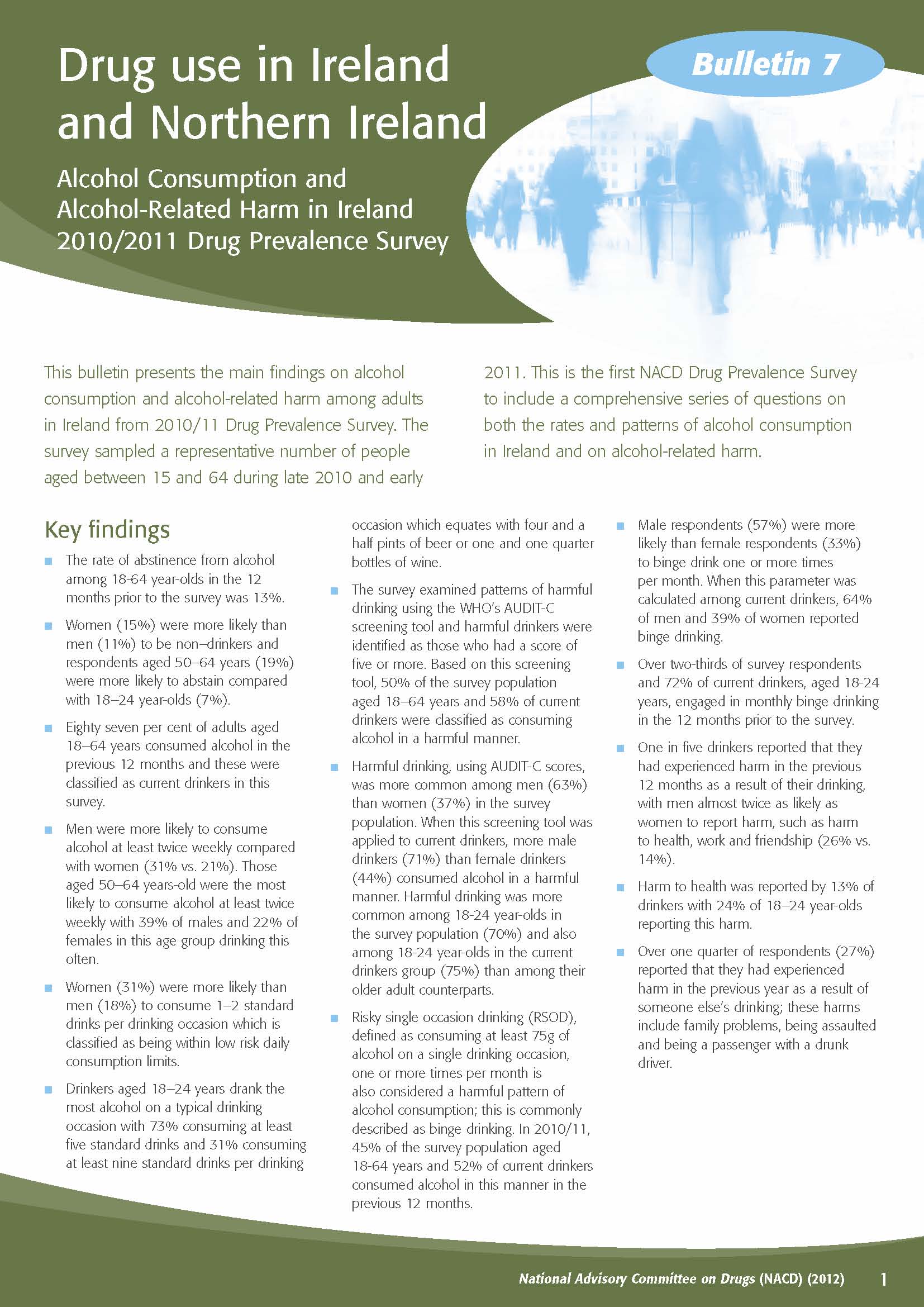Mongan, Deirdre
(2013)
Prevalence of alcohol consumption and alcohol-related harm in Ireland.
Drugnet Ireland,
Issue 44, Winter 2012,
p. 6.
On 24 September 2012, the National Advisory Committee on Drugs (NACD) published the main findings on alcohol consumption and alcohol-related harm among adults in Ireland from the 2010/11 general population drug prevalence survey.1 This is the first NACD drug prevalence survey to include a comprehensive series of questions on the rates and patterns of alcohol consumption and on alcohol-related harm. The survey involved a representative sample of people aged between 15 and 64 who were interviewed during late 2010 and early 2011. Only those aged 18–64 years (n=4,843) were included in the analysis of the alcohol responses as it is illegal for those aged 15–17 to buy alcohol and it was not feasible to analyse this group separately due to low numbers.
Frequency and volume of drinking
Eighty-seven per cent of adults aged 18–64 years consumed alcohol in the 12 months prior to the survey; these were classified as current drinkers. The remaining 13% were classified as non-drinkers. Women (15%) were more likely than men (11%) to be non–drinkers and respondents aged 50–64 years (19%) were more likely to be non-drinkers compared with 18–24-year-olds (7%). Previous research has indicated that people in Ireland consume alcohol less frequently than their European counterparts,2 but that when they do drink they consume more per drinking occasion than Europeans do. In this survey 31% of men and 21% of women consumed alcohol at least twice weekly. Those aged 50–64 years were the most likely to consume alcohol at least twice weekly, with 39% of males and 22% of females in this age group drinking this often. One quarter of respondents (24%) consumed 1–2 standard drinks3 per drinking occasion, which is classified as being within low-risk daily consumption limits, and this was most common among adults aged 50–64 years (34%). Forty per cent of drinkers in this survey consumed at least five standard drinks per drinking occasion.
Harmful drinking patterns
The survey examined patterns of harmful drinking using three measures: the World Health Organization’s AUDIT-C screening tool, which is used to identify people with harmful drinking patterns; the frequency of monthly risky single-occasion drinking (RSOD); and the RAPS screening tool, which is used to screen for alcohol dependence. According to the AUDIT-C screening tool, half of the population aged 18–64 years and 58% of current drinkers may be classified as harmful drinkers. Among current drinkers aged 18–24 years, 82% of males and 68% of females scored positive for harmful drinking.
Risky single-occasion drinking (RSOD), commonly described as ‘binge drinking’, is defined as consuming at least 75g of alcohol on a single drinking occasion; 75g is the equivalent of four pints of beer, or seven pub measures of spirits, or one 750ml bottle of wine. Half (52%) of all current drinkers engaged in RSOD at least once a month in the 12 months prior to the survey.
Based on the RAPS screening of behaviours in the 12 months prior to the survey, 23% of drinkers reported feelings of guilt or remorse after drinking; 24% reported that friends/family told them about things they said/did that they did not remember; 12% reported that they failed to do what was normally expected; 2% reported that they needed a first drink in the morning. Eighteen per cent (22% males; 13% females) of drinkers, had two or more positive scores on the RAPS screening tool. Those aged 18–24 years were most likely to have two positive scores (43%), compared with 7% among those aged 50–64 years.
Alcohol-related harm
One in five drinkers reported that they had experienced harm, such as harm to health, work, friendship, or being involved in a fight or an accident, in the previous 12 months as a result of their drinking, with men almost twice as likely as women to report such harm, (26% vs. 14%). Harm to health was reported by 13% of drinkers, with 24% of 18–24-year-olds reporting this harm. Over one quarter of respondents (27%) reported that they had experienced harm in the previous year as a result of someone else’s drinking; these harms include family problems, being assaulted and being a passenger with a drunk driver. Those who engaged in frequent RSOD were most likely to report alcohol-related harm from both their own and others’ drinking.
1. National Advisory Committee on Drugs and Public Health Information and Research Branch (2012) Drug use in Ireland and Northern Ireland. Alcohol consumption and acohol-related harm in Ireland: 2010/2011 Drug Prevalence Survey. Bulletin 7. Dublin: NACD and PHIRB. www.drugsandalcohol.ie/18439
3. A standard drink contains 10g of pure alcohol and is the equivalent of a half pint of beer/lager, or one pub measure of spirits, or one small (100ml) glass of wine.
Publication Type
Irish-related, Open Access, Article
Intervention Type
Screening / Assessment
Issue Title
Issue 44, Winter 2012
Publisher
Health Research Board
Volume
Issue 44, Winter 2012
Accession Number
HRB (Electronic Only)
Repository Staff Only: item control page
